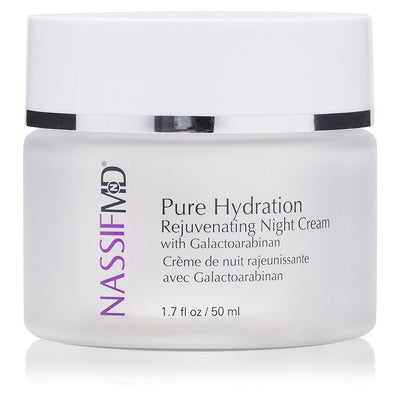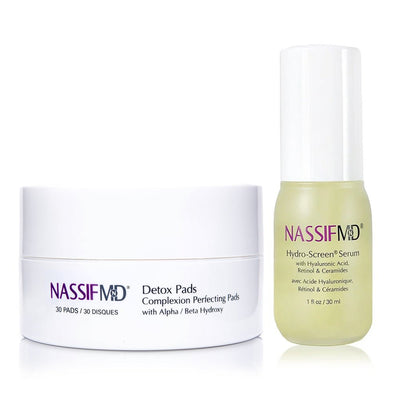What Is Skin Slugging in Skincare?
When it comes to social media skincare trends, skin slugging is much simpler than it sounds. It has nothing to do with slugs and doesn’t require any expensive tools or treatments. Skin slugging is a moisturizing trick to add to your skincare routine for effective skin hydration.
If you are looking for the best way to hydrate your skin, find out if slugging skin care is a good fit for you. Read on to learn more about:
- What is skin slugging?
- Is slugging good for your skin?
- How to hydrate skin and how to treat dry skin with Nassif MD Skin Barrier Balm (aka best practices for slugging skin)
Let’s get started!
What Is Skin Slugging?
Skin slugging involves the application of an occlusive to create a thick layer on the surface of the skin to seal in moisture. It protects the skin, restores the skin’s lipids (called sebum), and prevents transdermal water loss (evaporation from the skin).
The most well-known occlusives are petroleum-based products like Vaseline. But natural ingredients work just as well and include:
- Sunflower oil
- Jojoba oil
- Castor oil
- Olive oil
- Lanolin
- Beeswax
The product used for skin slugging will be thick, like a balm or salve, and won’t absorb onto the skin. It may appear slimy or greasy, which is how slugging gets its name after the slime a slug leaves behind.
The name doesn’t sound appealing, but skin slugging is a very easy treatment using an occlusive moisturizer. Let’s dive into occlusive skincare next.
Occlusive Moisturizer
There are four types of moisturizers:
- Emollients – Fatty acids to improve skin texture and appearance. Often used along with humectants. Examples: fatty acids, ceramides, squalene
- Humectants – Low molecular weight substances with water-attracting properties. Examples: alpha hydroxy acids, hyaluronic acid
- Protein rejuvenators – small proteins that help replenish natural proteins like collagen, elastin, and keratin. Examples: skincare peptides
- Occlusives – Oils and waxes that form a layer on the skin and physically block water loss. Examples: beeswax, sunflower oil, jojoba oil, etc.
An occlusive moisturizer is the product of choice for skin slugging. It’s a game-changer for dry skin.
Treating Dry Skin
It can be challenging if you’re looking for how to treat dry skin on your face. Many products only provide temporary relief and don’t get to the root of skin dehydration.
Skin slugging creates a physical barrier that drives other skincare products (like hyaluronic acid) deeper while preventing water loss, making it suitable for sensitive and dry skin. To understand why, let’s dive into the science behind the skin barrier.
Restoring the Skin Moisture Barrier
The outer layer of skin, called the epidermis, forms a barrier. The skin moisture barrier contains lipids (sebum), ceramides, and other protective molecules. It’s part of the immune system’s first line of defense. When functioning well, it keeps out harmful substances and pathogens while keeping in moisture.
The amount of water inside the skin determines the skin’s smoothness, elasticity, and appearance. Dry skin may primarily be due to the breakdown of the skin barrier, which allows for water loss from the skin.
Skin slugging protects skin barrier function and restores natural lipids, preventing water loss and producing more hydrated skin.
Evening Skincare Routine
Skin slugging is the last step of your nighttime skincare routine. We don’t suggest slugging during the day.
Here’s how to use an occlusive moisturizer for skin slugging:
- Clean your skin well. You don’t want to seal in any makeup, sunscreen, dirt, or other impurities.
- Follow cleansing with the rest of your regular skincare routine. You can use a hydrating serum and overnight moisturizer as you normally would.
- Apply the occlusive moisturizer over your face. We recommend NassifMD® Skin Barrier Balm – more on this below.
Remember, the skin slugging product doesn’t absorb into the skin, so you may want to sleep with a towel over your pillow. Be sure to cleanse your face the following morning.
You can skin slug daily or a few times per week. You may desire the practice more in the dryer winter months and less in the summer. Let your skin hydration guide you!
Is Slugging Right for Me?
Now that you see how simple skin slugging is, how do you know it’s right for you? It works best for dry and sensitive skin. If you have oily or acne-prone skin, proceed with caution.
Oily Skin
If you’re prone to oily skin, you may have enough of an oil barrier on your skin already. Occlusive treatments can trap dead skin and oils, resulting in oilier skin.
Acne Prone Skin
Like oily skin, if you are prone to acne, the increased oil could make acne worse. However, it may be beneficial if you have combination skin and experience both dry skin and acne. It’s okay to experiment. You can try a small area of your face first to see how your skin responds.
Dry Skin
Skin slugging is going to work best for treating dry skin. It creates a moisture barrier for the skin and traps in skincare ingredients and water while preventing evaporation.
NassifMD® Skin Barrier Balm is the best occlusive moisturizer to add to your evening skincare routine. Dr. Nassif developed this balm for his medical spa patients to use after skin rejuvenating treatments.
NassifMD® Skin Barrier Balm doubles as a skin slugging product, immediately hydrating and restoring skin barrier function. It soothes, calms, softens, and strengthens the skin while reducing redness, irritation, fine lines, and wrinkles. It’s non-comedogenic (won’t clog pores), and the gentle formula is perfect after medical spa treatments, and for severely dry or sensitive skin.
NassifMD® Skin Barrier Balm contains a blend of occlusive oils, including sunflower seed oil, castor oil, and jojoba oil. It also contains active ingredients to boost hydration and barrier function. These include:
- Centella Asiatica Extract – an antioxidant-rich plant extract for intense moisturizing and skin barrier support
- Ophiopogon Japonicus Root Extract – a plant extract rich in polysaccharides to hydrate the skin and prevent moisture loss
- Niacinamide – a form of vitamin B3 known to decrease inflammation, reduce skin irritation, boost skin metabolism, and improve skin barrier function
- Panthenol – a form of vitamin B5 to help strengthen skin cells, boost hydration, and reduce redness
If you have dry or sensitive skin and are looking to improve skin hydration and build a stronger epidermis, try skin slugging. The practice only adds a minute to your evening skincare routine but will leave your skin calm, hydrated, and protected.
References
- Sethi, A., Kaur, T., Malhotra, S. K., & Gambhir, M. L. (2016). Moisturizers: The Slippery Road.Indian journal of dermatology, 61(3), 279–287.
- Nguyen, A. V., & Soulika, A. M. (2019). The Dynamics of the Skin's Immune System.International journal of molecular sciences, 20(8), 1811.
- Hamishehkar, H., Same, S., Adibkia, K., Zarza, K., Shokri, J., Taghaee, M., & Kouhsoltani, M. (2015). A comparative histological study on the skin occlusion performance of a cream made of solid lipid nanoparticles and Vaseline.Research in pharmaceutical sciences, 10(5), 378–387.
- Buranasudja, V., Rani, D., Malla, A., Kobtrakul, K., & Vimolmangkang, S. (2021). Insights into antioxidant activities and anti-skin-aging potential of callus extract from Centella asiatica (L.).Scientific reports, 11(1), 13459.
- Lei, F., Weckerle, C. S., & Heinrich, M. (2021). Liriopogons (Genera Ophiopogonand Liriope, Asparagaceae): A Critical Review of the Phytochemical and Pharmacological Research. Frontiers in pharmacology, 12, 769929.
- Voegeli, R., Guneri, D., Cherel, M., Summers, B., Lane, M. E., & Rawlings, A. V. (2020). Topical niacinamide enhances hydrophobicity and resilience of corneocyte envelopes on different facial locations.International journal of cosmetic science, 42(6), 632–636.
- Nisbet, S. J., Targett, D., Rawlings, A. V., Qian, K., Wang, X., Lin, C. B., Thompson, M. A., Bulsara, P. A., & Moore, D. J. (2019). Clinical and in vitro evaluation of new anti-redness cosmetic products in subjects with winter xerosis and sensitive skin.International journal of cosmetic science, 41(6), 534–547.






















